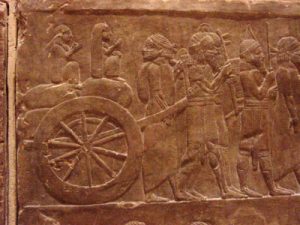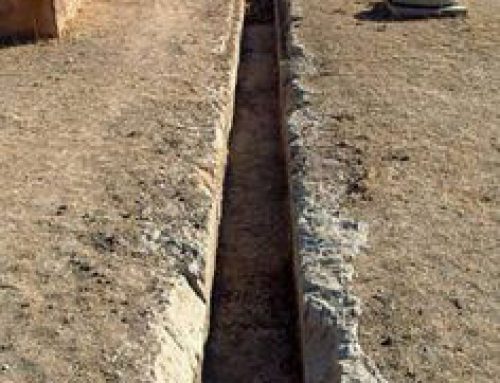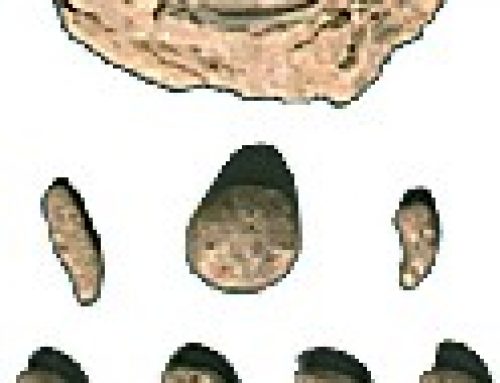
Assyrian history: the head of an Akkadian king (maybe Sargon, who invaded Assur)
Where did the Assyrians live?
We first hear of the Assyrians around 2300 BC. That’s when Sargon of Akkad invaded their small kingdom, Assur, in what is now Syria. (Syria is named for the Assyrians.)
More on the Akkadians
The Bronze Age
All our Mesopotamia articles
Early Assyrian traders
About 2000 BC, Assur became independent of the collapsing 3rd Dynasty of Ur.
Third Dynasty of Ur
History of donkeys
West Asian Economy
Then the Assyrians became well-known traders. They travelled constantly between Assur and what is now southern Turkey with their donkeys.
Cloth manufacturing and Assyrian women

A cuneiform letter from one Assyrian cloth trader to another.
They lived well, with big houses and many employees. In Assur, Assyrian women spun, dyed, and wove wool and linen cloth for their husbands or brothers to sell.
History of spinning
What is linen?
The wool trade
Assyrian women ran large businesses in Assur while the men travelled.
Girls and young women
Married women
Cloth trade with the Hittites
Assyrian traders carried this cloth from Assur on their donkeys. They also brought tin from beyond the Tigris in Iran. The men traded their cloth and tin in southern Turkey for gold, silver, and other metals.
History of bronze
Hittites in West Asia
But as the Hittites took over that area around 1800 BC, this trade gradually collapsed. The last Assyrian caravan to the Hittite territory was ca. 1780 BC.

Iraq
The Amorites and the Hurrians
By 1700 BC Amorites conquered the Assyrians. Later the Hurrians ruled the Assyrians for a long time. But then the Hurrian kingdom collapsed about 1360 BC.
More about the Amorites
Assur-uballit, the first King of Assyria
The Assyrian governor of Assur, whose name was Assur-uballit, saw his chance and began calling himself the King of Assyria.
Assur-uballit and the Assyrians soon had to fight both the Hurrians and the Kassites in order to stay independent. But they won their wars and were able to establish themselves.
They made a lot of alliances with the Kassites to their south. Many Assyrian princesses married Kassite princes and the other way around.
Tukulti-Ninurta (Nimrod) conquers Babylon
Under their king Tukulti-Ninurta I (known in the book of Genesis as Nimrod), about 1225 BC, the Assyrians conquered the Kassites and the city of Babylon, capturing the great statue of the god Marduk there and bringing it back to Assur.
More about the god Marduk
But people objected to this sacrilege, and the conquest of Babylon. A mob led by his son burned Tukulti-Ninurta to death by setting fire to his palace. The people freed the Kassites again.
The Assyrians at the end of the Bronze Age
A Dark Age overtook West Asia about this time, with the invasions of the Sea Peoples and a lot of movement among the Hittites, the Hurrians, and the Jews, and the gradual collapse of the Kassites as a result.
Who were the Sea Peoples?
A Dark Age in West Asia

The Assyrian king
Tiglath-Pileser I: the Assyrian Empire grows
The Assyrians were the only big kingdom in West Asia not to collapse as a result of the Dark Ages, and so they were in a good position to take over afterward.
By 1115 BC, under their king Tiglath-pileser I, they were able to expand south into Babylonia again (being more careful to respect the ancient gods there this time), and west.
At first, these were basically plundering expeditions. The Assyrian army, which was feared everywhere, started out pretty much every spring going south along the Tigris river. Then the army would cross to the Euphrates and follow that upstream until it got home again to Assur, around the end of the summer.
Assyrian tribute expeditions
Along the way the soldiers collected whatever they liked: cloth, gold, pearls, artwork, or slaves.
History of pearls
What about gold?
History of slavery
Assyrian inscriptions call this “tribute”, but people either gave it in order to keep from being attacked, or the Assyrian soldiers attacked them and took it anyway. These plundering expeditions continued more or less every year for hundreds of years, down to Assurnasirpal’s reign in the 800s BC.

Wheeled wagon carrying prisoners of war (Nineveh, Iraq, 700 BC)
Shalmaneser III
Assurnasirpal’s son Shalmaneser III decided to expand the Assyrian empire even more. He took the plundering expeditions even further west, where he first met the Jewish kingdoms of Israel and Judah.
More about Israel and Judah
Assyrian wars with Israel and Judah
At first the Jews resisted Shalmaneser successfully, but by the 830s Shalmaneser seems to have placed pro-Assyrian Jews on the thrones of both kingdoms. We guess that he collected tribute as well.
Learn by doing: making an Assyrian relief
The end of the Assyrians
Bibliography and further reading about the Assyrians:
Mesopotamia, by Pamela Service (1998). Down to the Persian conquest of the area.
Find Out About Mesopotamia: What Life Was Like in Ancient Sumer, Babylon and Assyria, by Lorna Oakes (2004).
Ancient Mesopotamians, by Elena Gambino (2000). Retellings of Mesopotamian stories and lots of context.
Ancient Near Eastern History and Culture, by William H. Stiebing (2002). Expensive, and hard to read, but it’s a good up to date account.




